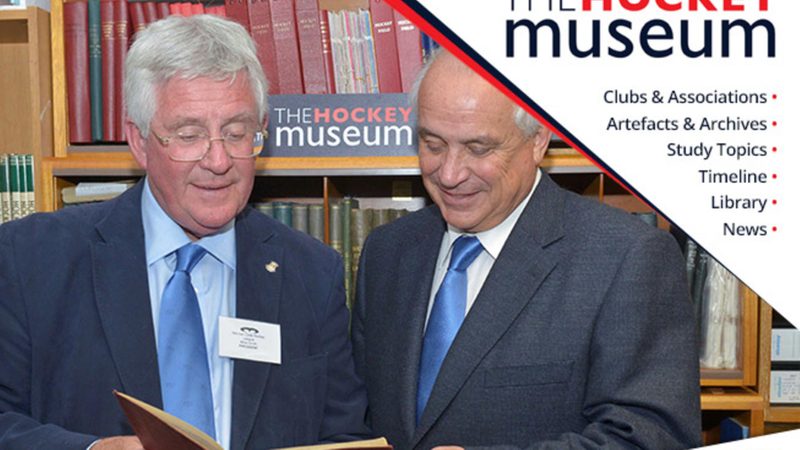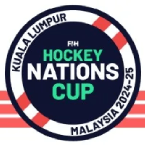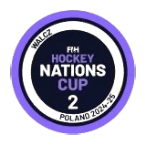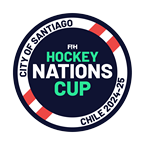
The Hockey Museum might be a celebration of all that has happened in hockey’s long and exciting history, but the folk running the museum are anything but backward looking.
Led by Mike Smith, the committed and enthusiastic volunteers have been making huge strides forward since they moved into their current premises – just 40 minutes by train from London.
The EuroHockey Championships in August 2015 brought The Hockey Museum into the international public eye to a far greater extent. The Museum had an exhibition marquee at the Championships, with a spectacular window display of clothing, equipment and programmes and a number of amazing artefacts for hockey enthusiasts to pore over.
Among the exhibition pieces were hockey outfits from different eras. These included a selection of original ‘hockey in art’ items from all around the world, a display of 125 years of Wimbledon Ladies Hockey Club, original archive material from the beginning of the 20th century, displays of pin badges, stamps – including the first ever stamp depicting a hockey stick, which originated in Japan – and postcards from all over the world.
There was also the ever popular range of old hockey sticks and balls and a large TV screen showing cine-film footage of coaching sessions and matches from the mid 20th century.
More than 4,500 spectators visited the exhibition during the event and many people also brought collections of hockey paraphernalia in as a donation or promised to donate them further down the line. The four months since the EuroHockey Championships have been busier than ever and this has fuelled its trustee’s ambitions.
“We have gone from a few collections in a garage to a recognised museum seeking accreditation by 2016 in just four years, that is an incredible achievement,” says curator and one of the original founders, Mike Smith.
With the support of the International Hockey Federation (FIH), the Museum now has its first paid employee, a collections management officer, and Smith is hoping a professional curator will be on board at some point in the near future. “I am a curator who knows little about curation,” says Smith modestly. “I really need to be the Director, and leave someone who knows what they are doing to curate.”
One of the biggest projects being undertaken at the moment is the 'Oral Histories' project. The Hockey Museum received a grant from the English Heritage Lottery Fund that is supporting the recording of interviews with a range of people who have been influential in the development of the game.
The project was launched at the EuroHockey Championships, where 19 oral histories were recorded, including one with FIH President Leandro Negre. Many more interviews are planned but, as Smith points out, speed of implementation is increasingly necessary.
“The trouble with oral histories is that you have to get them done before we irretrievably and inevitably lose the subjects.” The museum is looking to outside sources for help in presenting these histories. Smith points to the Museum of British Surfing as a sport that showcases its oral histories in a really innovative way. “We are talking to them to get some guidance on how best to showcase our own oral histories."
The support is not all one-way. Following its discussions with FIH, The Hockey Museum is also starting to talk with other nations who want to start their own national hockey archives or museums.
“Protecting hockey’s heritage around the world is really important and we have offered our support and advice to groups in Ireland, India, Italy and the Netherlands,” says Smith. “They are all at various stages of getting their own national museums up and running. We plan to present at the FIH Congress in 2016 and this might spark interest in other nations.”
One of the things that really sparked interest at the EuroHockey Championships was the 60 metre-long timeline, which was displayed along one wall of the Spectator Plaza.
The series of images over 19 panels represent key points in the development of hockey from the Egyptians in 2000BC to the present day. It was commissioned by England Hockey and designed by one of the museum volunteers, Martin Ellis.
The timeline has set a precedent for future similar projects, the 2016 Women’s Champions Trophy and the 2018 Men’s World Cup will both be held in London and timelines charting these tournament’s history will feature heavily in The Hockey Museum’s offering.
However, one of the biggest challenges for The Hockey Museum and its volunteers is to take the wealth of information about the history of the sport and bring it to life.
One of the aims, says Smith, will be to produce an authoritative commentary and history of the sport, and that means further research and study.
A scoping study into the feasibility of such an ambition is in its earliest stages, but the aim is for an authoritative and substantial body of work to be produced, reflecting hockey’s worldwide heritage, in time for the FIH centenary in 2024.
A number of topics are already being researched and some books, articles and papers have been published or are under way, but much is still to be done.
The newly-formed partnerships with FIH, Woking Borough Council, the Surrey Museums partnership and a host of researchers and volunteers from around the world will help this small, but busy museum achieve its aims.
There is no doubt that The Hockey Museum is undertaking an incredibly important role in preserving the history of hockey. However, in doing so they are also helping inspire others to get into hockey and remain engaged with the sport - a key concept of the FIH's Hockey Revolution which aims to make hockey a global game that inspires the next generation.
To find out more about The Hockey Museum, visit their website: hockeymuseum.net
























